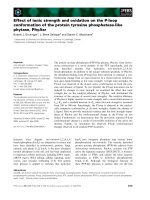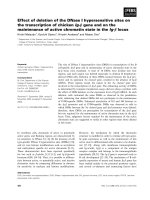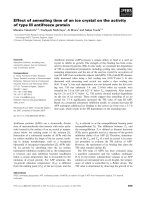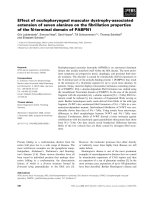Báo cáo khoa học: " Effect of the medical emergency team on long-term mortality following major surgery"
Bạn đang xem bản rút gọn của tài liệu. Xem và tải ngay bản đầy đủ của tài liệu tại đây (729.13 KB, 9 trang )
Open Access
Available online />Page 1 of 9
(page number not for citation purposes)
Vol 10 No 2
Research
One year ago not business as usual: Wound management,
infection and psychoemotional control during tertiary medical
care following the 2004 Tsunami disaster in southeast Asia
Marc Maegele
1,2
, Sven Gregor
3
, Nedim Yuecel
1
, Christian Simanski
1
, Thomas Paffrath
1
,
Dieter Rixen
1
, Markus M Heiss
3
, Claudia Rudroff
3
, Stefan Saad
3
, Walter Perbix
4
, Frank Wappler
5
,
Andreas Harzheim
6
, Rosemarie Schwarz
7
and Bertil Bouillon
1
1
Department of Traumatology and Orthopedic Surgery, Cologne-Merheim Medical Center (CMMC), University of Witten/Herdecke,
Ostmerheimerstrasse, 51109 Cologne, Germany
2
Intensive Care Unit of the Department of Traumatology and Orthopedic Surgery, CMMC, University of Witten/Herdecke, Ostmerheimerstrasse,
51109 Cologne, Germany
3
Department of Visceral Surgery, CMMC, University of Witten/Herdecke, Ostmerheimerstrasse, 51109 Cologne, Germany
4
Department of Plastic and Reconstructive Surgery, CMMC, University of Witten/Herdecke, Ostmerheimerstrasse, 51109 Cologne, Germany
5
Department of Anaesthesiology, CMMC, University of Witten/Herdecke, Ostmerheimerstrasse, 51109 Cologne, Germany
6
Department of Radiology, CMMC, University of Witten/Herdecke, Ostmerheimerstrasse, 51109 Cologne, Germany
7
Department of Microbiology, CMMC, University of Witten/Herdecke, Ostmerheimerstrasse, 51109 Cologne, Germany
Corresponding author: Marc Maegele,
Received: 3 Jan 2006 Revisions requested: 16 Feb 2006 Revisions received: 20 Feb 2006 Accepted: 26 Feb 2006 Published: 29 Mar 2006
Critical Care 2006, 10:R50 (doi:10.1186/cc4868)
This article is online at: />© 2006 Maegele et al.; licensee BioMed Central Ltd.
This is an open access article distributed under the terms of the Creative Commons Attribution License ( />),
which permits unrestricted use, distribution, and reproduction in any medium, provided the original work is properly cited.
Abstract
Introduction Following the 2004 tsunami disaster in southeast
Asia severely injured tourists were repatriated via airlift to
Germany. One cohort was triaged to the Cologne-Merheim
Medical Center (Germany) for further medical care. We report
on the tertiary medical care provided to this cohort of patients.
Methods This study is an observational report on complex
wound management, infection and psychoemotional control
associated with the 2004 Tsunami disaster. The setting was an
adult intensive care unit (ICU) of a level I trauma center and
subjects included severely injured tsunami victims repatriated
from the disaster area (19 to 68 years old; 10 females and 7
males with unknown co-morbidities).
Results Multiple large flap lacerations (2 × 3 to 60 × 60 cm) at
various body sites were characteristic. Lower extremities were
mostly affected (88%), followed by upper extremities (29%),
and head (18%). Two-thirds of patients presented with
combined injuries to the thorax or fractures. Near-drowning
involved the aspiration of immersion fluids, marine and soil
debris into the respiratory tract and all patients displayed signs
of pneumonitis and pneumonia upon arrival. Three patients
presented with severe sinusitis. Microbiology identified a variety
of common but also uncommon isolates that were often multi-
resistant. Wound management included aggressive
debridement together with vacuum-assisted closure in the
interim between initial wound surgery and secondary closure. All
patients received empiric anti-infective therapy using quinolones
and clindamycin, later adapted to incoming results from
microbiology and resistance patterns. This approach was
effective in all but one patient who died due to severe fungal
sepsis. All patients displayed severe signs of post-traumatic
stress response.
Conclusion Individuals evacuated to our facility sustained
traumatic injuries to head, chest, and limbs that were often
contaminated with highly resistant bacteria. Transferred patients
from disaster areas should be isolated until their microbial flora
is identified as they may introduce new pathogens into an ICU.
Successful wound management, including aggressive
debridement combined with vacuum-assisted closure was
effective. Initial anti-infective therapy using quinolones
combined with clindamycin was a good first-line choice.
Psychoemotional intervention alleviated severe post-traumatic
stress response. For optimum treatment and care a
multidisciplinary approach is mandatory.
CMMC = Cologne-Merheim Medical Center; ER = emergency department; ESBL = extended-spectrum β-lactamase; MRSA = methicillin-resistant
Staphylococcus aureus.
Critical Care Vol 10 No 2 Maegele et al.
Page 2 of 9
(page number not for citation purposes)
Introduction
Following the 2004 tsunami disaster that hit southeast Asia
and killed over 225,000 people [1,2], severely injured tourists
from various European countries were evacuated via airlift to
Germany using German Air Force Airbus A310 MRT MedEvac
transport [3-5]. Triage upon arrival at Cologne-Bonn Military
Airport identified a cohort of 17 patients requiring further inten-
sive medical care. This cohort was immediately transferred to
the nearest level 1 trauma center of the region, the Cologne-
Merheim Medical Center (CMMC). Rapid communication on
different aspects associated with the long-distance air trans-
fer, characteristic injury patterns, microbiological and psych-
oemotional findings at a very early stage following the disaster
have previously been published [5,6]. The focus of the present
report is given to tertiary medical care provided to this unique
cohort of patients, in particular with respect to complex wound
management, infection and psychoemotional control. Accord-
ing to the concept of a trimodal distribution of medical prob-
lems after large-scale disasters [7], the cohort evacuated to
our facility had already entered the third phase of post-disaster
medical care. During this phase (days to weeks after the tragic
event) major efforts were undertaken to prevent and treat com-
plications.
Materials and methods
Patients
Seventeen severely injured tsunami victims (19 to 68 years of
age; 10 females and 7 males with unknown co-morbidities)
needing further sophisticated medical care were immediately
transferred to the CMMC (level 1 trauma center) following
long distance tertiary air transfer and triage at Cologne-Bonn
Military Airport. Detailed information on triage and initial care in
the disaster region [8,9] and medical aspects associated with
the airlift to Germany have been provided [5]. The patients
arrived in our facility on average five days (three groups: range
three to seven days) following the disaster. Upon arrival in our
emergency department (ER), seven patients were intubated
and mechanically ventilated and three patients needed cate-
cholamines. All patients underwent standard clinical assess-
ment and management as routinely performed on incoming
patients, including rapid stabilization of vital parameters, phys-
ical and neurological examination, radiography and laboratory
analysis. Patients on catecholamines upon arrival showed clin-
ical and laboratory signs of severe sepsis [10].
Complex wound management via vacuum-assisted
closure therapy
Vacuum-assisted closure therapy (VAC Vakuumquellen, KCI
Therapiegeräte, Höchstadt, Germany) was designed to pro-
mote the formation of granulation tissue in the wound bed,
either as an adjunct to surgical therapy or as an alternative to
surgery [11]. In detail, foam dressing with an attached evacu-
ation tube is inserted into the wound and covered with an
adhesive drape creating an airtight seal. Controlled, localized
negative pressure is applied and effluents from wounds are
collected into a nearby cannister. It is hypothesized that nega-
tive pressure contributes to wound healing by: (i) removing
infectious materials and excess interstitial fluids, thus allowing
tissue decompression [12]; (ii) increasing the vascularity of
the wound, thus improving cutaneous perfusion [13,14]; (iii)
promoting granulation tissue formation [15,16]; and/or (iv)
creating beneficial mechanical forces that draw wound edges
closer together. Vacuum-assisted wound closure may be con-
sidered medically necessary for patients with complicated sur-
gical wounds when both of the following criteria are met: (i)
need for accelerated formation of granulation tissue that can-
not be achieved by other available topical wound treatments;
and (ii) there is risk or co-morbidity present that is expected to
significantly prolong healing achievable with other topical
wound treatments [17]. A complicated surgical wound is a
wound likely to take significantly longer to heal than a similar
wound without complications, such as a large dehiscence or
a significant wound infection.
Microbiology
Surveillance cultures are a standard procedure in our facility
when patients have been transferred or admitted from other
areas or hospitals. Multiple and multifocal microbiological
assessments were performed in each patient immediately
upon arrival. Wound swabs, nasal swabs and respiratory tract
specimens were cultured on the following agars: (i) Columbia
5% sheep blood; (ii) Mac Conkey; (iii) Chocolat+ PolyVite X
(PVX) (Biomerieux, Nuertingen, Germany); (iv) Schaedler Kan-
amycin-Vancomycin 5% sheep blood (Becton Dickinson, Hei-
Figure 1
Wound management via vacuum-assisted closure therapyWound management via vacuum-assisted closure therapy. (a) Large-scale tissue damage at hip and upper lower extremity. (b) Vacuum-assisted clo-
sure therapy. (c) Successful skin grafting.
Available online />Page 3 of 9
(page number not for citation purposes)
delberg, Germany); (v) Thioglycolat bouillon; and (vi)
Sabouraud (Biomerieux, Nuertingen, Germany). Aerobic and
anaerobic incubation, when appropriate for culture media, was
performed at 35°C. Bacterial strains were identified using the
Vitek 2 system and the API identification system (Biomerieux,
Nuertingen, Germany). Antibiotic susceptibility was deter-
mined using the Vitek 2 system, disc-diffusion susceptibility
testing and the E-Test (Ab Biodisk, Solna, Sweden). In those
patients presenting with clinical signs of sepsis or who were
highly suspicious for developing sepsis (n = 4), three sets of
blood cultures were obtained immediately upon arrival and cul-
tivated according to standard procedures and protocols.
Psychological interventions
A severe degree of psychoemotional trauma was expected
among all incoming patients and relatives and psychothera-
peutic support was introduced as early as possible. The serv-
ice was provided by the department's psychotherapeutic
intervention team consisting of three qualified and experi-
enced psychotraumatologists available 24 hours a day, 7 days
a week upon request. Psychological services included psych-
oemotional support, intervention and counselling.
Results
Wound management
Physical examination upon arrival at the ER revealed a pattern
of severe large-scale soft-tissue damage common to 16/17
victims. Multiple large flap lacerations at various body sites
were characteristic, ranging from 2 × 3 cm to 60 × 60 cm in
size (Figures 1a, 2a and 3a, 3b). Lower extremities were
mostly affected (88%), followed by upper extremities (29%),
and head (18%). Two-thirds of patients had combined injuries
to the thorax (for instance, pneumo-/hemopneumothorax),
including intrapulmonary contusions and lesioning, and frac-
tures of the extremities, both open and closed. Initial wound
management focused on surgical removal of devitalized tissue
and aggressive debridement. During the interim between initial
wound surgery and secondary closure, wounds were pro-
tected using vacuum-assisted closure (Figures 1b and 3a, 3c,
3f). Renewal of vacuum-assisted wound dressings was per-
formed in two to three day intervals under sterile conditions in
the operating theatre. In two cases, amputations were inevita-
ble due to septic microembolism resulting in severe acral
necrosis (Figure 3f, left). Following conditioning (Figures 2b
and 3d, 3e), wounds were closed either with or without skin
grafting (Figures 1c, 2c and 3f).
Infection control
Wounds
Although wounds had already been cleaned and treated dur-
ing the initial phase of care at primary medical facilities, all
wounds were significantly contaminated with foreign material
upon arrival of the patients in our facility (for example, with sea-
water, mud, sand, vegetation, corals, etc.). Cultures from
repetitive wound swabs grew a variety of pathogens as sum-
Figure 2
Wound management from primary surgery to delayed secondary closureWound management from primary surgery to delayed secondary closure. (a) Large-scale tissue damage at right lower extremity. (b) Cross-over
technique for wound edge adaptation. (c) Definitive wound closure via suture.
Figure 3
Wound management from primary surgery to delayed secondary clo-sureWound management from primary surgery to delayed secondary clo-
sure. (a-c) Large-scale tissue damage at both lower extremities and
vacuum sealing. (d,e) Wound site fills with granulation tissue. (f) Skin
grafting at right lower extremity. Note that toe amputations had to be
performed at right lower extremity due to severe septic microembolism.
Critical Care Vol 10 No 2 Maegele et al.
Page 4 of 9
(page number not for citation purposes)
marized in Figure 4 and Table 1. Among those, a substantial
number of highly resistant species was identified, including
multiply resistant Acinetobacter baumanii, intermediate sensi-
tive to ampicillin/sulbactam only, Enterococcus faecium, sen-
sitive to glycopeptides only, extended-spectrum β-lactamase
(ESBL) producing Escherichia coli and multi-resistant Proteus
vulgaris, both sensitive to carbapenems, amikacin, and qui-
nolones only, Pseudomonas aeruginosa, sensitive to carbap-
enems and tobramycin only, methicillin-resistant
Staphylococcus aureus (MRSA), sensitive to fosfomycin,
rifampicin, linezolid and glycopeptides only, and Stenotropho-
monas maltophilia, sensitive to ofloxacin only. Polymicrobial
wound contamination also included contamination with fungi
(for instance, Candida albicans as well as non-albicans spe-
cies), and moulds that were identified as Mucor species,
Fusarium solani and Aspergillus fumigatus.
Respiratory tract
Tsunami near-drowning involved the aspiration of immersion
fluids as well as marine and soil debris into the respiratory
tract, thus producing intrapulmonary inoculation of bacteria. In
accordance, all patients admitted to our facility displayed radi-
ological and clinical signs of pneumonitis and pneumonia (Fig-
ure 5). Similar to wounds, microbiology from upper and lower
respiratory tracts revealed a variety of common but also
uncommon pathogens, including a substantial number of
highly resistant species (Figure 4). For example, multiply resist-
ant A. baumanii was isolated from respiratory tract specimens
from all three patients that were in a septic state and required
catecholamines upon ER arrival. Cultures further grew multiply
resistant E. faecium, sensitive to glycopeptides only, Kleb-
siella pneumoniae, intermediate sensitive to amikacin only,
MRSA, sensitive to fosfomycin, rifampicin, linezolid and glyco-
Figure 5
Chest radiography upon arrival displayed signs of pneumonia, for exam-ple, in the right lower lobeChest radiography upon arrival displayed signs of pneumonia, for exam-
ple, in the right lower lobe.
Figure 4
Resistance patterns for isolates from blood cultures, respiratory tracts, serum, and woundsResistance patterns for isolates from blood cultures, respiratory tracts, serum, and wounds. Isolates with multiple resistancies are in bold.
a
Location:
bc, blood culture; rt, respiratory tract; s, serum; w, wounds.
b
B. distasonis, fragilis, thetaiotaomicron. ESBL, extended-spectrum β-lactamase; I, inter-
mediate sensitive; R, resistant; S, sensitive.
Location
Penicillin
Ampicillin
Ampi/Sulba
Mezlocillin
Piperacillin
Pip/Tazobac
Oxacillin
Cefalotin
Cefuroxim
Cefotaxim
Ceftazidim
Cefepim
Imipenem
Meropenem
Gentamicin
Tobramycin
Amikacin
Ofloxacin
Ciprofloxacin
Clindamycin
Fosfomycin
Erythromycin
Rifampicin
Vancomycin
Teicoplanin
Isolates
Acinetobacter baumanii bc/rt/s/w R I R R R/I R R R R R R R
Aeromonas hydrop hilia w R R I R R R R S R R I/S S I S I/S
Aeromonas veronii w R R R R R R S S R R I R I
Alcaligenes xylooxydans bc/rt/s R S S R S S S S R R R
Bacillus species w R R R R R R S I S S R S R S S
Bacteroides caccae bc/s/w
Bacteroides species* w
Burkholderia cepacia rt R S S I S I/S R S R R R S M
Clostridium septicum bc/s
Corynebacterium striatum w R R R I S R R R R R R S S
Enterobacter aerogenes w R R S S S R R S S S S S
Enterobacter cloacae w R R S S S R R S S S S S
Enterococcus faecalis bc/rt/s/w R S S R R R S R R/I/S R R R/S R/S S S
Enterococcus faecium bc/rt/s/w R R R R R R R R R R R R R/I S S
E.coli (ESBL +) bc/s/w R R R R R R R R S R S I
Klebsiella pnemoniae rt R R R R R R R R S R I R
Morganella morganii w R R S S S R R S S S S S S S S
Proteus mirabilis w S S S S S S S S S S S S
Proteus vulgar is w R R R R R R R R S I I S
Pseudomonas aeruginosa bc/s/w R R R I I R R R R I S S R/I/S R I S
S. aureaus (MRSA) bc/rt/s/w R R R R R R R R R S R S S S
Stenotrophomonas maltophilia bc/rt/s/w R R R R R R/I R R R R R S I
Available online />Page 5 of 9
(page number not for citation purposes)
peptides only, and Stenotrophomonas maltophilia, sensitive to
quinolones only.
Sinusitis
Injuries associated with the tsunami disaster also involved
sinusitis from inhaled seawater. Computed tomography from
three patients showed fluid and opaque material in the eth-
moid, maxillary, and sphenoid sinuses (Figure 6a, 6b) and
purulent material and sand was removed via repeated wash-
outs. Cultures from this material as well as from repeated nasal
swabs grew multiply resistant A. baumanii, intermediate sen-
sitive to ampicillin/sulbactam only, E. faecium, sensitive to
glycopeptides only, and C. albicans. Cultures from nasal
swabs from one patient were also highly suspicious for mould
that was later identified as Aspergillus fumigatus (Table 1).
Systemic infection
Multiply resistant pathogens isolated from wounds, respiratory
tracts and nasal swabs of three patients who arrived in a
hemodynamically unstable condition had obviously triggered
sepsis as these pathogens were also isolated from a series of
blood cultures collected immediately upon ER arrival. Accord-
ingly, blood cultures grew multiply resistant A. baumanii, inter-
mediate sensitive to ampicillin/sulbactam only, E. faecalis,
sensitive to ampicillin, carbapenemes, and glycopeptides only,
E. faecium, sensitive to glycopeptides only, ESBL producing
E. coli, sensitive to carbapenems, amikacin, and quinolones
only, MRSA, sensitive to fosfomycin, rifampicin, linezolid and
glycopeptides only, and S. maltophilia, sensitive to ofloxacin
only (Figure 4).
Anti-infective therapy
All patients received empiric anti-infective therapy immediately
upon arrival using a combination of quinolones and clindamy-
cin. Anti-infective management was immediately adopted
according to incoming results from microbiology and resist-
ance patterns (Figure 4). Carbapenems and glycopeptides
were frequently used within the later course to control infec-
tions involving multiply resistant E. faecium and faecium,
MRSA, Aeromonas species, ESBL producing E. coli, P. aeru-
ginosa, K. pneumoniae, and S. maltophilia. Attempts to con-
trol infection with multiply resistant A. baumanii involved
sulbactam, if sensitive. In selected patients positive for MRSA,
in which vancomycin was not effective, linezolid was applied.
Fungal infections involving C. albicans as well as non-albicans
species were successfully treated with voriconazole. Anti-
infective treatment combined with consequent wound debri-
dement and removal of devitalized tissues was effective in all
but one patient. This patient was already highly septic on
arrival at our facility, requiring high doses of catecholamines.
He further presented with beginning renal and pulmonary fail-
ure. Microbiology from wounds, respiratory tract and blood
cultures identified a high level of contamination with multiple
multiply resistant pathogens, for example, E. faecalis and fae-
cium, C. albicans, F. solani, A. fumigatus, P. aeruginosa and
MRSA from wounds, A. baumanii, Alcaligenes xylooxidans, E.
faecalis and faecium, K. pneumoniae, MRSA and S. mal-
tophilia from the respiratory tract, Candida species and E. fae-
cium from blood cultures, and E. faecium and A. fumigatus
from nasal swabs. Within the later course, this patient devel-
oped severe fungal sepsis that could not be controlled. This
patient died on day 32 following evacuation from the disaster
area.
Table 1
Yeast and mould species isolated from blood cultures,
respiratory tracts, serum, and wounds
Isolate Location
Aspergillus fumigatus rt/w
Candida albicans bc/rt/s/w
Candida glabrata w
Candida tropicalis bc/s/w
Fusarium solani w
Mucor species w
Bc, blood culture; rt, respiratory tract; s, serum; w, wounds.
Figure 6
Computed cranial tomography (CCT): Arrows indicate fluid and opaque material in the (a) ethmoid and (b) maxillary sinusesComputed cranial tomography (CCT): Arrows indicate fluid and
opaque material in the (a) ethmoid and (b) maxillary sinuses.









